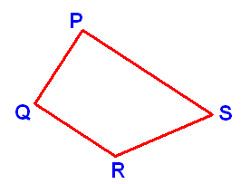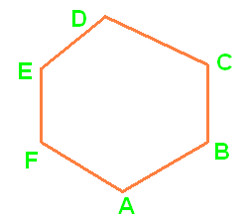Definition: In a polygon, the end points of same side is referred to as Adjacent Vertices
In the following polygon,

Side PS has two end points i.e. P & S, So P & S are Adjacent Vertices.
Side SR has two end points i.e. S & R, So S & R are Adjacent Vertices.
Side RQ has two end points i.e. R & Q, So R & Q are Adjacent Vertices.
Side QP has two end points i.e. Q & P, So Q & P are Adjacent Vertices.
Let study following figure also and find all Adjacent Vertices:
Figure 1

In the above figure, following are the pair of adjacent vertices.
A & C
C & D
D & B
B & A
Figure 2

In the above figure, following are the pair of adjacent vertices.
D & C
C & B
B & A
A & F
F & E
E & A
|






